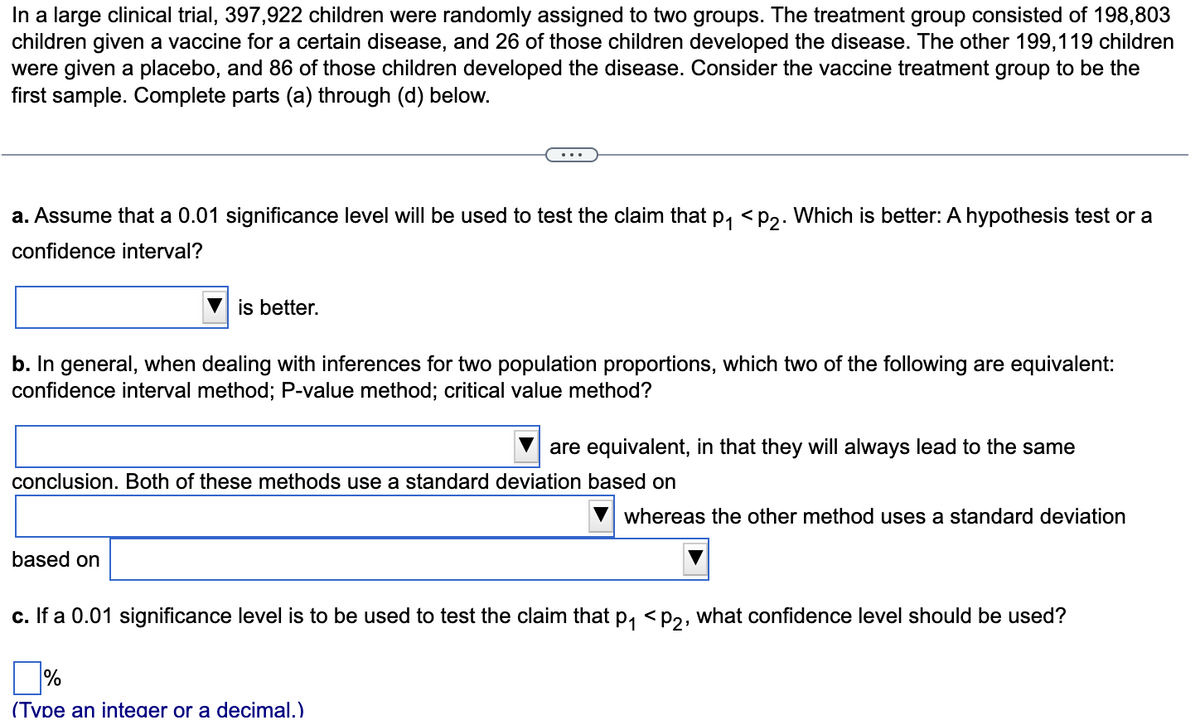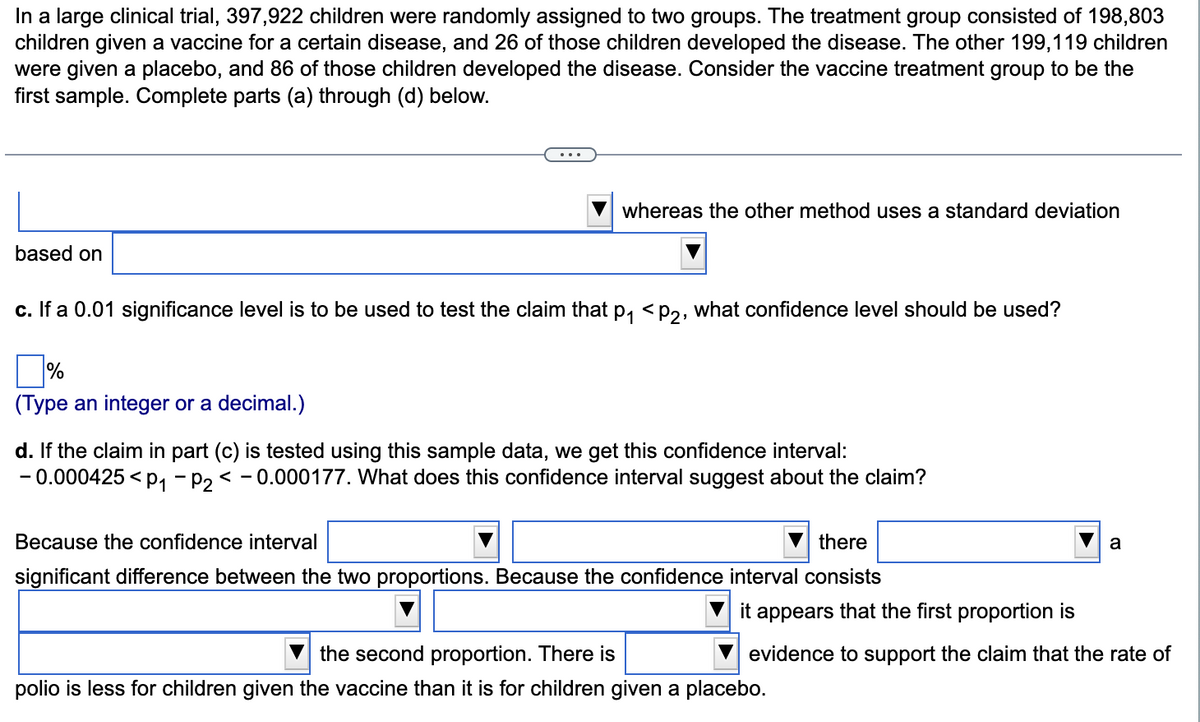In a large clinical trial, 397,922 children were randomly assigned to two groups. The treatment group consisted of 198,803 children given a vaccine for a certain disease, and 26 of those children developed the disease. The other 199,119 children were given a placebo, and 86 of those children developed the disease. Consider the vaccine treatment group to be the first sample. Complete parts (a) through (d) below. a. Assume that a 0.01 significance level will be used to test the claim that p,
In a large clinical trial, 397,922 children were randomly assigned to two groups. The treatment group consisted of 198,803 children given a vaccine for a certain disease, and 26 of those children developed the disease. The other 199,119 children were given a placebo, and 86 of those children developed the disease. Consider the vaccine treatment group to be the first sample. Complete parts (a) through (d) below. a. Assume that a 0.01 significance level will be used to test the claim that p,
Holt Mcdougal Larson Pre-algebra: Student Edition 2012
1st Edition
ISBN:9780547587776
Author:HOLT MCDOUGAL
Publisher:HOLT MCDOUGAL
Chapter11: Data Analysis And Probability
Section: Chapter Questions
Problem 8CR
Related questions
Question
5.

Transcribed Image Text:In a large clinical trial, 397,922 children were randomly assigned to two groups. The treatment group consisted of 198,803
children given a vaccine for a certain disease, and 26 of those children developed the disease. The other 199,119 children
were given a placebo, and 86 of those children developed the disease. Consider the vaccine treatment group to be the
first sample. Complete parts (a) through (d) below.
a. Assume that a 0.01 significance level will be used to test the claim that p, <p2. Which is better: A hypothesis test or a
confidence interval?
is better.
b. In general, when dealing with inferences for two population proportions, which two of the following are equivalent:
confidence interval method; P-value method; critical value method?
are equivalent, in that they will always lead to the same
conclusion. Both of these methods use a standard deviation based on
whereas the other method uses a standard deviation
based on
c. If a 0.01 significance level is to be used to test the claim that p, < p2, what confidence level should be used?
%
(Tvpe an inteaer or a decimal.)

Transcribed Image Text:In a large clinical trial, 397,922 children were randomly assigned to two groups. The treatment group consisted of 198,803
children given a vaccine for a certain disease, and 26 of those children developed the disease. The other 199,119 children
were given a placebo, and 86 of those children developed the disease. Consider the vaccine treatment group to be the
first sample. Complete parts (a) through (d) below.
...
whereas the other method uses a standard deviation
based on
c. If a 0.01 significance level is to be used to test the claim that p, <p2, what confidence level should be used?
%
(Type an integer or a decimal.)
d. If the claim in part (c) is tested using this sample data, we get this confidence interval:
- 0.000425 < p, - p2 < -0.000177. What does this confidence interval suggest about the claim?
Because the confidence interval
there
a
significant difference between the two proportions. Because the confidence interval consists
it appears that the first proportion is
the second proportion. There is
evidence to support the claim that the rate of
polio is less for children given the vaccine than it is for children given a placebo.
Expert Solution
This question has been solved!
Explore an expertly crafted, step-by-step solution for a thorough understanding of key concepts.
This is a popular solution!
Trending now
This is a popular solution!
Step by step
Solved in 2 steps with 2 images

Recommended textbooks for you

Holt Mcdougal Larson Pre-algebra: Student Edition…
Algebra
ISBN:
9780547587776
Author:
HOLT MCDOUGAL
Publisher:
HOLT MCDOUGAL

College Algebra (MindTap Course List)
Algebra
ISBN:
9781305652231
Author:
R. David Gustafson, Jeff Hughes
Publisher:
Cengage Learning

Holt Mcdougal Larson Pre-algebra: Student Edition…
Algebra
ISBN:
9780547587776
Author:
HOLT MCDOUGAL
Publisher:
HOLT MCDOUGAL

College Algebra (MindTap Course List)
Algebra
ISBN:
9781305652231
Author:
R. David Gustafson, Jeff Hughes
Publisher:
Cengage Learning